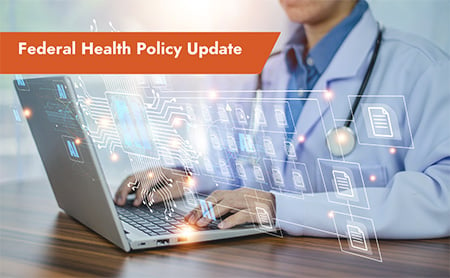Balancing AI Innovation in Health Care with Federal Legislation
January 19, 2024 | Catherine Jones

As artificial intelligence (AI) is rapidly evolving, so is the federal legislative landscape. With AI becoming more embedded in health care—its increasing use in public health—Congress has increased its focus on presenting research that demonstrates how technology interacts with existing and proposed federal regulations to ensure that those paradigms do not cause harm at clinical and population levels. In late 2023, three important Congressional hearings plus President Biden’s executive order (EO) wrapped up a busy year and set the stage for 2024.
Defining AI in Health Care
While difficult, it is imperative to define AI in health care and its practical translations in clinical and public health settings. President Biden’s EO offers a comprehensive definition of AI: a machine-based system that can, for a given set of human-defined objectives, make predictions, recommendations or decisions influencing real or virtual environments.” The scope of this definition is not limited to generative AI or machine learning technologies as it potentially impacts any machine-based system that makes predictions, recommendations, or decisions.
Use of AI in Health Care and Public Health
The integration of AI in health care and public health is gaining traction. In clinical settings, AI has the potential to reduce the burden of administrative paperwork (e.g., insurance verifications and pre-authorizations), facilitate patient transcription and documentation (e.g., in emergency rooms), automate scheduling and basic communications, improve diagnosis and treatment of certain diseases and pathologies, and enable a number of disease-specific risk predictions.
In public health, AI may play a role in policy, program and intervention planning, decreasing workforce burnout, disease surveillance and outbreak detection, emergency response, health communication and promotion, preventing diagnostic errors and hospitalizations, cutting down on over-investigating patients, reducing fraud, advancing telehealth, and impacting drug and AI-based medical device research, development, and manufacturing.
Summary of AI Hearings in Late 2023
With potential technological advances come the formidable challenges of patient privacy, data security, transparency, coverage, bias, and equity, all of which require federal legislation to play a vital role. The November House Energy and Commerce congressional hearing sought to address AI in health care and to offer potential solutions from witnesses.
- Experts shared that human bias is baked into technology and, left unchecked, it can exacerbate racial and ethnic bias and discrimination resulting in the denial of care, inappropriate care, or negative outcomes.
- AI systems indefinitely copy forward fundamental flaws from their training datasets (a concept known as “garbage in, garbage out”), raising the need for a national standard for collecting and handling health care data.
- Safeguards to protect the privacy and security of data in ambulatory or clinical-based care, in-home-direct-to-patient care, as well as direct-to-consumer health advice systems (i.e., mobile apps) operate with less oversight than hospitals and require more attention.
- Keeping the “human in the loop” is a shared preference among both patients and providers.
- Coverage is another sticking point, with experts suggesting that CMS needs updated ways to monitor and reimburse AI-related tools and processes.
The November Senate Health Education Labor and Pensions hearing and the December House Energy and Commerce Congressional hearing covered similar issues and raised new ones.
- While AI has the potential to expedite and de-risk the drug development process, witnesses encouraged FDA to ensure the efficacy and safety of AI-developed drugs.
- Diagnostic errors—one of the most common errors impacting 12 million people with unnecessary medical costs of more than $100 billion–could be mitigated with AI, but AI should accompany a doctor’s medical judgement and not replace it. Furthermore, when an error occurs—the committee asks—who is liable, the human or algorithm?
- Nationally, health care fraud costs about $300 billion annually. Suspicious billing patterns can be detected with AI. AI-based fraud detection pilot programs for CMS and NIH are in development.
- In the wrong hands, U.S.-developed AI has the potential to proliferate knowledge regarding the manufacturing of dangerous pathogens and biological weapons around the globe, a chilling fact that elevates the necessity for strict oversight to mitigate biosecurity risks.
President Biden’s Executive Order on AI
The goal of President Biden’s October EO was to establish the first set of standards for using AI in health care and other industries. Specific to public health, the EO covers reducing risks at the intersection of AI and Chemical, Biological, Radiological and Nuclear (CBRN) threats. It advances the 2024 Leading Edge Acceleration Project cooperative agreement to improve health care-data quality to support responsible development of AI algorithms and tools for clinical care, real-world-evidence programs, population health, public health, and related research. It outlines accelerating grants awarded through the NIH Artificial Intelligence/Machine Learning Consortium to Advance Health Equity and Researcher Diversity (AIM-AHEAD) program and showcases current related activities in underserved communities.
What’s Ahead for 2024?
While 2024 heralds many uncertainties, AI will continue to be a hot topic in health care and on Capitol Hill. To improve public health—prevention, diagnosis, treatment, equity, and outcomes—future policy, legislation, and federal funding could focus on individual patient and public health impacts, including equitable distributions of AI benefits and risks across the population. The good news is that developing safe, reliable, trustworthy, and unbiased AI advancements in health care along with proper oversight protections seems to be a priority on both sides of the aisle. ASTHO will continue to monitor federal legislation focused on AI and its impacts on public health.
Related Content
Artificial Intelligence in State and Territorial Public Health
Public health data experts discuss all things AI.
View MoreAI in Public Health—ASTHO Has Entered the Chat
The basics of Artificial Intelligence for public health professionals.
View More